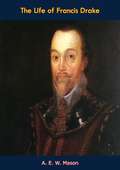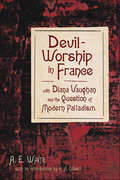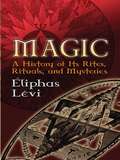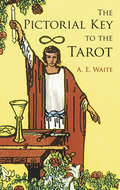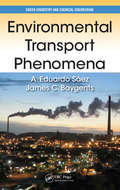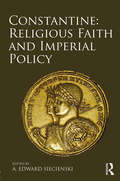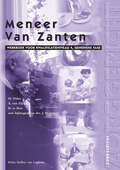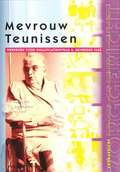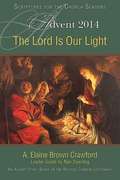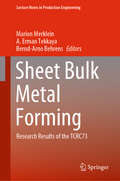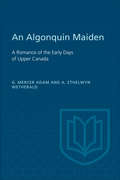- Table View
- List View
The Tarot: Large Print
by Manly P. Hall Arthur Edward Waite Papus S. L. Mathers F. Homer Curtiss Harriette Augusta Curtiss A. E. Thierens Eliphaz Levi P. D. Ouspensky P. R. Foli"A major contribution!”—Rachel Pollack, bestselling author of Seventy-Eight Degrees of WisdomThe definitive collection of rare, secret, and arcane tarot knowledgeThe Tarot: A Collection of Secret Wisdom from Tarot's Mystical Origins is the ultimate guide to the mysteries and lost knowledge of the tarot. This single volume includes more than ten selections from foundational tarot books, all from the 19th and 20th century. Many of these critical texts have been forgotten, fallen out of print, or are impossible to acquire. The Tarot reintroduces these books to the modern-day reader, unlocking the invisible power of the tarot for a new generation of card readers.The Tarot includes the following complete books:The Tarot by S. L. MacGregor MathersThe Magical Ritual of the Sanctum Regnum by Eliphaz LeviFortune Telling by Cards by P. R. S. FoliThe Pictorial Key to the Tarot by Arthur Edward WaiteThe Symbolism of the Tarot by P.D. OuspenskyThe Tarot of the Bohemians by PapusThe Key to the Universe by Harriette Augusta Curtiss & F. HomerThe Key of Destiny by Harriette Augusta Curtiss & F. HomerThe General Book of the Tarot by A.E. ThierensThe Tarot also includes additional selections from Manly P. Hall and others. Featuring over 400 original black-and-white illustrations throughout the book, The Tarot is a gorgeous gift and an irresistible invitation to both seasoned readers and beginners to explore the esoteric wisdom of the cards.
The Expendables
by A. E. Van VogtThe alien was deadly, dangerous and inhuman—but he was not the most feared enemy on the ship! Lesbee recognized that his plan to take control of the ship had been discovered. But what other options did he have? What else could he do? And then, of course, there were the aliens that they all had to deal with.
The Wizard of Linn
by A. E. Van VogtEarth was helpless after the atomic holocaust--ready prey for the worst threat of all, the invaders from an alien galaxy...WAS MAN DOOMED FOREVER TO SENDING MESSAGES BY SMOKE SIGNALS?The Earth, after the atomic holocaust, had reverted to a strange kind of barbarism where men could build space ships but could not communicate except by the most primitive means.So it was a sickening shock to Lord Clane Linn when he captured one of the alien invader's space ships and discovered that their central headquarters in another galaxy was sending them messages and getting answers.There was no possibility of sneak attack against such an enemy. With this weapon alone the aliens could win the war--unless Earthmen discovered the secret and how to use it...before the next assault.ALONE AGAINST THE UNIVERSEThe alien Riss were coming to destroy Earth. Everyone knew it, but they did nothing. They were too busy fighting among themselves, planning bigger spectacles for the arena and engaging in petty intrigues to gain petty power.Only the mutant, Clane, knew how to fight the Riss. But he could count on no support from his fellow Earthmen. This was a task he must perform unaided...
The Dark Invader: Wartime Reminiscences Of A German Naval Intelligence Officer
by A. E. W. Mason Captain Franz von RintelenMen engaged in Intelligence Services during a war divide their particular opponents into two classes. One consists of neutrals who go out of their way to help the enemy for the sake of gain; and for such men we have not much compassion should they fall upon misfortune. They are interfering in great matters with which they are not concerned, in order to make a little money. The other class is made up of men who, abandoning the opportunities of their own careers, go secretly away in the sacred service of their country, play a lone hand, and run the gauntlet of foreign laws. For such we can have nothing but respect while the fight is going on and friendship when it is over.Captain Franz von Rintelen belongs to this latter class. A young naval officer with every likelihood of reaching to high rank, he went abroad in 1915 and only saw his own country again after the lapse of six strenuous and, in part, unhappy years. The history of those years is told in this book. The conversations which he records depend, of course, upon his memory; the main facts we are able to check, and we know them to be exact.The book is written, as one would expect from his record, without the least rancour, and I think I am not trenching upon the province of criticism when I add--with admirable simplicity. It is a record which is more detailed and concerned with endeavours on a vastly wider scale than is usual in such accounts. One cannot, I think, read it without recognising, apart from the magnitude of the things attempted and done, the terrific strain under which he lived; and this gives a moving and human quality to the narrative which sets it a little apart from any other which I have read. Those who are most saturated in spy stories will find much to surprise them in this volume, and they will not be likely to forget the poignant minutes which he spent on the top of an omnibus in London and the way in which those minutes ended.Finally, here is as good an argument against War as a man could find in twenty volumes devoted to that subject alone.
The Four Feathers
by A. E. W. MasonThis classic adventure story -- first published in1902 -- gains new life in a blockbuster motion picture epicfrom Paramount Pictures and Miramax Films and remainsa timeless novel of love, honor, and courage. A Soldier's Shame. . . It is 1882 and British officer Harry Feversham has it all: a loving fiancée, the camaraderie of fellow soldiers, a bright future in a nation at the height of its imperial power. But before he is deployed to battle in Africa, he resigns -- and receives white feathers, symbols of cowardice, from three friends. . . and then a fourth from his fiancée. A Love Lost. . . Ethne Eustace has pushed Harry out of her life, but not out of her mind. Still, when another suitor comes calling she makes a decision that could destroy Harry. . . and alter her life forever. A Heroic Redemption. . . His world in tatters, Harry goes undercover in Africa to win back the respect of his comrades. From the bustling markets of Cairo to the sizzling sands of Omdurman prison, he fights with everything he has to bring honor back to his name. . . and Ethne back to his heart.
The Life of Francis Drake
by A. E. W. MasonThe usual picture of Drake in men’s minds is a brave, bluff man of infinite audacity, a great patriot, a great sailor, a man to whom success came of its own accord.But this is only half the truth.He was always studying and learning. He reached success by the painful ways of failure. Few men have stood up to so many rebuffs in early manhood and snatched victory out of them. In many respects he was in advance of his time—in none perhaps more than the kindness and humanity he showed to native peoples.He confronted a vast world power determined to enslave England and destroy its claim to think as it thought and live in independence. He shattered that power by changing the naval strategy of England from defence to attack. And his theory of sea-warfare, developed by Nelson two centuries later, remains the principle of the Royal Navy today.It is this man of whose life A. E. W. Mason has written.
Devil-Worship in France: with Diana Vaughn and the Question of Modern Palladism
by A. E. WaiteA.E. Waite's Devil-Worship in France, rather than being an infernal how-to book or even a history of what the title purports, is in fact an examination of a most sensational hoax perpetrated by Parisian journalist, Leo Taxil. Taxil and fictitious associate, Diana Vaughan, created a scandal in the late 1800s by reporting on a most heinous occult sect, the "Palladian Masons," that admitted women and performed diabolic acts of "Luciferian Spiritism." Taxil's "revelation" of this secret society and its supposed links to Freemasonry and other occult organizations, created a public hysteria and outcry against all things occult, especially secret societies.A.E. Waite's response, Devil-Worship in France, is his satirical and somewhat farcical interpretation of this sensationalization and persecution of occult groups in France at that time. This work, along with similar refutations by French occultist Papus, raised questions Taxil could not answer, and he was forced to admit that the reports were a hoax meant to ridicule both the Catholic Church and Freemasonry. This republication of Devil-Worship in France is the first reprint of the book in nearly one hundred years.A.E. Waite then wrote Diana Vaughan and the Question of Modern Palladism, the sequel to Devil-Worship in France, where he reexamined and re-presented the telling of the hoax in a straightforward manner- without the satire and farce. Published for the first time, here, finally, is the whole story behind the hoax that slandered occult communities throughout Europe in the late 1800s. R.A. Gilbert's introduction places the book in historical and contemporary context.
Magic: A History of Its Rites, Rituals, and Mysteries
by A. E. Waite Éliphas Lévi"The most arresting, entertaining, and brilliant of all studies on the subject." — Arthur Edward WaiteA great work of literature as well as a pioneering classic of occultism, this voluminous historical survey traces the roots and manifestations of magic through the ages as a secret tradition persisting from remote times. Author Éliphas Lévi, pseudonym of Alphonse Louis Constant (1810-75), was a leader of the French occult revival, a spiritual teacher and magus who is today considered by some to be a founding father of the New Age movement. One of his most stunning (and original) revelations connects the Kabbalah with the Tarot, thus helping to inspire the ongoing fascination with the symbols of both, and their correspondences with each other. In this 1860 work, Lévi's discussions include topics that continue to intrigue modern readers, subjects as seemingly disparate as the mathematical magic of Pythagoras, magical monuments, magic and Christianity, the devil, the Knights Templar, alchemy, the illuminati, hallucinations, and many others that are equally alluring.The first part of the book explains the principles underlying magical operations, while the second part addresses the actual ritual and practice of transcendent magic. An essential resource for the library of anyone interested in mysticism and the occult sciences, this influential work appears here in its first English translation (from the original French) by the distinguished scholar and co-creator of the Rider-Waite Tarot deck, A. E. Waite.
The Book of Ceremonial Magic
by A. E. WaiteNoted occult historian A. E. Waite created this meticulously researched survey in order to unite and interpret the scattered and often-inaccessible details of magical traditions. Part I contains essential passages from prominent magical texts dating from the fourteenth, fifteenth, and sixteenth centuries; Part II analyzes these texts from a modern perspective. A century after its debut, Waite's work remains among the best sources of information on occult subjects related to the study of the supernatural. Although the author does not condone the practice of black magic, he defends occult practitioners and praises the disciplines of astrology and alchemy. Modern readers will find this book an extraordinarily complete tour of the history of magic, replete with details of casting spells, conjuring spirits, and other occult practices.
The Pictorial Key to the Tarot (Dover Occult Ser.)
by A. E. WaiteLong used in telling fortunes and popular today among New Agers, Tarot cards are regarded by many as "the training wheels" on the bicycle of psychic development. Centuries of scientific progress have not diminished the irresistible attraction of gazing at picture cards to see the future and determine one's fate. This book by Arthur Edward Waite, the designer of the most widely known Tarot deck and distinguished scholar of the Kabbalah, is the essential Tarot reference. The pictorial key contains a detailed description of each card in the celebrated 78-card Rider-Waite Tarot deck, along with regular and reversed meanings. Contents describe symbols and secret tradition; the four suits of Tarot, including wands, cups, swords, and pentacles; the recurrence of cards in dealing; an ancient Celtic method of divination; as well as wonderful illustrations of Tarot cards.While the perfect complement to old-style fortune telling, The Pictorial Key to the Tarot also serves to make the Tarot entirely accessible to modern-day readers. It is also the classic guide to the Rider-Waite deck and to Tarot symbolism in general.
Barnardo of Stepney: The Father of Nobody's Children (Routledge Revivals)
by A. E. WilliamsFirst published in 1943, this third edition of Barnardo of Stepney was published in 1966, when it was a hundred years since a young man of twenty arrived in London on his way from Dublin to China. A change of plan delayed his departure and, instead of becoming a missionary in the foreign field, he stayed here to become the most remarkable freelance in awakening humanity’s fight against poverty, and the beloved Father of Nobody’s Children.Of the thousands of men and women who eventually worked under his leadership and close personal direction, A. E. Williams, his personal secretary in the closing years of his life, is the only one who had attempted to set down on paper a full-length portrait of this remarkable, dauntless, delightful Irishman who turned the whole thought of his age upside-down on the question of the rights and possibilities of children and helped free all humanity from concepts of the damning power of heredity and early environment into the inspiring knowledge that a man can be ‘born again’.Still at his post at Stepney Causeway throughout the years of Hitler’s war, A. E. Williams set down his record-accurate, intimate, entertaining, inspiring – hailed eventually by The Times as ‘one of the most interesting, human and revealing biographies that have appeared for many a year’ and by The New Statesman as ‘one of the most instructive and entertaining personal studies of the century’.This centenary edition carried a wealth of fine new illustrations which brought the story of the Barnardo organization, the Doctor’s great legacy to the nation and the world, right up to date. Still going strong today, Barnardo’s continues to support children, young people and families who need them.This book is a re-issue originally published in 1943. The language used and views portrayed are a reflection of its era and no offence is meant by the Publishers to any reader by this re-publication.
Environmental Transport Phenomena (ISSN)
by A. Eduardo Saez James C. BaygentsThis book offers a detailed yet accessible introduction to transport phenomena. It begins by explaining the underlying principles and mechanisms that govern mass transport, and continues by tackling practical problems spanning all subdisciplines of environmental science and chemical engineering. Assuming some knowledge of ordinary differential equations and a familiarity with basic fluid mechanics applications, this classroom-tested text addresses mass conservation and macroscopic mass balances, placing a special emphasis on applications to environmental processes and presenting a mathematical framework for formulating and solving transport phenomena problems.
Constantine: Religious Faith and Imperial Policy
by A. Edward SiecienskiConstantine: Religious Faith and Imperial Policy brings together some of the English-speaking world’s leading Constantinian scholars for an interdisciplinary study of the life and legacy of the first Christian emperor. For many, he remains a "sign of contradiction" (Luke 2:34) whose life and legacy generate intense debate. He was the first Christian emperor, protector of the Church, and eventually remembered as "equal to the apostles" for bringing about the Christianization of the Empire. Yet there is another side to Constantine’s legacy, one that was often neglected by his Christian hagiographers. Some modern scholars have questioned the orthodoxy of the so-called model Christian emperor, while others have doubted the sincerity of his Christian commitment, viewing his embrace of the faith as merely a means to a political end. Drawing together papers presented at the 2013 symposium at Stockton University commemorating the 1700th anniversary of the Edict of Milan, this volume examines the very questions that have for so long occupied historians, classicists, and theologians. The papers in this volume prove once again that Constantine is not so much a figure from the remote past, but an individual whose legacy continues to shape our present.
Investigating Classroom Talk
by A. Edwards D. P. WestgateIn this fully revised and extended edition, Tony Edwards and David Westgate continue to examine methods of investigation for use in classrooms and ways in which researchers and teachers may advance their knowledge of classroom talk. They have taken the opportunity to add material on oracy and the importance of spoken language in the curriculum.; All research evidence and bibliographic material has been revised and updated. This book should continue to be an important text for a new generation of students and researchers in language and linguistics, social science and education studies.
The Lord Is Our Light
by Nan Duerling A. Elaine Brown CrawfordThe Lord is Our Light invites you to explore God's hope and presence through a study of the scripture readings for Advent and Christmas. Key Bible readings call us to praise God as we actively wait for the coming of God's redemption and new creation. Through the readings, we hear the call to celebrate the light of God revealed through Jesus Christ. The season of Advent offers opportunities to prepare for God's coming in human form in the baby Jesus and for the approach of God's kingdom with the second coming of Christ. Hope is the focus of Advent worship, study, and prayer. We will discover the light that began in the manger and that continues as we look forward with hope to Christ's return. The Lord is Our Light is based upon the Revised Common Lectionary scriptures for year B of the church year, a three-year cycle of Bible readings. The study includes commentary and reflection on readings from the Old Testament, the Gospels, and the Epistles. It offers the opportunity to explore these Bible readings in a five-session study. The goal is to help participants understand, appreciate, and engage in meaningful and joyous celebrations of Advent and Christmas and to live each day in God's light through Jesus Christ. The study book includes a leader guide with information about the season of Advent, suggestions for starting and leading small groups, Bible background, and discussion activities
The Lord Is Our Light [Large Print]: An Advent Study Based on the Revised Common Lectionary
by Nan Duerling A. Elaine Brown CrawfordThe Lord Is Our Light invites you to explore God’s hope and presence through a study of the scripture readings for Advent and Christmas. Author Elaine Crawford calls us to explore our hope for new beginnings, praising God as we eagerly await the birth of Christ in our lives. Recalling the fulfillment of God’s promises at Christmas, she invites us to imagine the future culmination of our hope in Christ’s death, resurrection, and second coming. Dawson’s reflections challenge readers to cultivate faithful lives here and now, in active expectation for the coming of the Christ Child. Based upon the Revised Common Lectionary scriptures for year B of the church year, a three-year cycle of Bible readings. The study includes commentary and reflection on key Bible readings from the Old Testament, the Gospels, and the Epistles. It offers the opportunity to explore these Bible readings in a five-session study. It will help participants understand, appreciate, and engage in meaningful and joyous celebrations of Advent and Christmas and to live each day in God's light through Jesus Christ. The study book includes a leader guide with information about the season of Advent, suggestions for starting and leading small groups, Bible background, and discussion activities.
Writing Anthropologists, Sounding Primitives: The Poetry and Scholarship of Edward Sapir, Margaret Mead, and Ruth Benedict (Critical Studies in the History of Anthropology)
by A. Elisabeth ReichelWriting Anthropologists, Sounding Primitives re-examines the poetry and scholarship of three of the foremost figures in the twentieth-century history of U.S.-American anthropology: Edward Sapir, Margaret Mead, and Ruth Benedict. While they are widely renowned for their contributions to Franz Boas&’s early twentieth-century school of cultural relativism, what is far less known is their shared interest in probing the representational potential of different media and forms of writing. This dimension of their work is manifest in Sapir&’s critical writing on music and literature and Mead&’s groundbreaking work with photography and film. Sapir, Mead, and Benedict together also wrote more than one thousand poems, which in turn negotiate their own media status and rivalry with other forms of representation. A. Elisabeth Reichel presents the first sustained study of the published and unpublished poetry of Sapir, Mead, and Benedict, charting this largely unexplored body of work and relevant selections of the writers&’ scholarship. In addition to its expansion of early twentieth-century literary canons, Writing Anthropologists, Sounding Primitives contributes to current debates about the relations between different media, sign systems, and modes of sense perception in literature and other media. Reichel offers a unique contribution to the history of anthropology by synthesizing and applying insights from the history of writing, sound studies, and intermediality studies to poetry and scholarship produced by noted early twentieth-century U.S.-American cultural anthropologists.
Verification, Validation and Testing of Engineered Systems
by A. EngelSystems' Verification Validation and Testing (VVT) are carried out throughout systems' lifetimes. Notably, quality-cost expended on performing VVT activities and correcting system defects consumes about half of the overall engineering cost. Verification, Validation and Testing of Engineered Systems provides a comprehensive compendium of VVT activities and corresponding VVT methods for implementation throughout the entire lifecycle of an engineered system. In addition, the book strives to alleviate the fundamental testing conundrum, namely: What should be tested? How should one test? When should one test? And, when should one stop testing? In other words, how should one select a VVT strategy and how it be optimized? The book is organized in three parts: The first part provides introductory material about systems and VVT concepts. This part presents a comprehensive explanation of the role of VVT in the process of engineered systems (Chapter-1). The second part describes 40 systems' development VVT activities (Chapter-2) and 27 systems' post-development activities (Chapter-3). Corresponding to these activities, this part also describes 17 non-testing systems' VVT methods (Chapter-4) and 33 testing systems' methods (Chapter-5). The third part of the book describes ways to model systems' quality cost, time and risk (Chapter-6), as well as ways to acquire quality data and optimize the VVT strategy in the face of funding, time and other resource limitations as well as different business objectives (Chapter-7). Finally, this part describes the methodology used to validate the quality model along with a case study describing a system's quality improvements (Chapter-8). Fundamentally, this book is written with two categories of audience in mind. The first category is composed of VVT practitioners, including Systems, Test, Production and Maintenance engineers as well as first and second line managers. The second category is composed of students and faculties of Systems, Electrical, Aerospace, Mechanical and Industrial Engineering schools. This book may be fully covered in two to three graduate level semesters; although parts of the book may be covered in one semester. University instructors will most likely use the book to provide engineering students with knowledge about VVT, as well as to give students an introduction to formal modeling and optimization of VVT strategy.
Asymptotic Expansions (Dover Books on Mathematics)
by A. ErdélyiOriginally prepared for the Office of Naval Research, this important monograph introduces various methods for the asymptotic evaluation of integrals containing a large parameter, and solutions of ordinary linear differential equations by means of asymptotic expansions. Author's preface. Bibliography.
60 Excellent Inventions in Metal Forming
by A. Erman Tekkaya Werner Homberg Alexander Brosius60 novel approaches in metal forming are presented and explained in detail. Contributions from acknowledged international scientists representing the state-of-art in metal forming open a general view on recent results and a clear view on demands for new research initiatives.
Engineering Education 4.0
by Sabina Jeschke A. Erman Tekkaya Sulamith Frerich Tobias Meisen Anja Richert Marcus Petermann Uwe WilkesmannThis book presents a collection of results from the interdisciplinary research project "ELLI" published by researchers at RWTH Aachen University, the TU Dortmund and Ruhr-Universit#65533;t Bochum between 2011 and 2016. All contributions showcase essential research results, concepts and innovative teaching methods to improve engineering education. Further, they focus on a variety of areas, including virtual and remote teaching and learning environments, student mobility, support throughout the student lifecycle, and the cultivation of interdisciplinary skills.
Sheet Bulk Metal Forming: Research Results of the TCRC73 (Lecture Notes in Production Engineering)
by A. Erman Tekkaya Bernd-Arno Behrens Marion MerkleinThis book presents the findings of research projects from the Transregional Collaborative Research Centre 73. These proceedings are the result of years of research into sheet–bulk metal forming. The book discusses the challenges posed by simulating sheet–bulk metal forming. It takes into account the different phenomena characteristic to both sheet and bulk forming fields, and explores the demands this makes on modelling the processes. It then summarizes the research, and presents from a practitioner's point of view. This means the book is of interest to and helps both academics and industrial engineers within the field of sheet–bulk metal forming.
An Algonquin Maiden: A Romance of the Early Days of Upper Canada
by G. Mercer Adam A. Ethelwyn WetheraldShort excerpt: Man versus nature-the successive assaults of perishing humanity upon the almost impregnable fortresses of the eternal forests-this was the struggle of Canadian civilization, and its hard-won triumphs were bodied forth in the scattered roofs of these cheap habitations.





